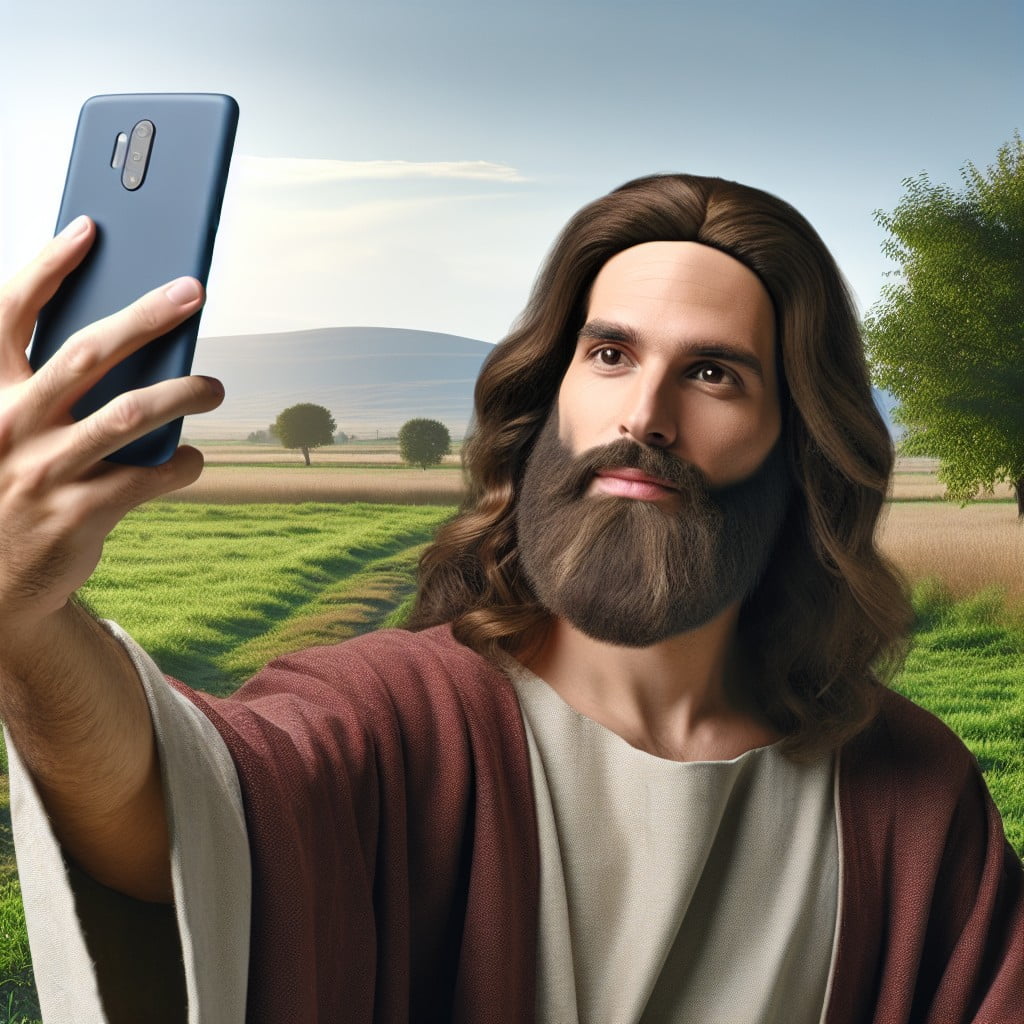Delve into this thought-provoking analysis of AI-generated biblical images because it offers an intriguing perspective on the fusion of religion and cutting-edge technology.
Key takeaways:
- Personalization of Faith: Using digital tools to create a personal connection with Jesus.
- Technological Convergence: Adapting religious devotion to modern communication methods.
- Visual Testimony: Sharing faith through images on social media platforms.
- Accessibility: Advances in technology make religious art accessible to a global audience.
- Diversity: The digital landscape showcases Jesus imagery from different cultures.
Understanding the Concept of “Jesus Selfie”

At its core, the term refers to the trend of depicting oneself with an image of Jesus, typically using photo manipulation software to achieve a sense of personal connection with the divine. This concept intertwines modern technology with ancient religious iconography.
Here are essential points to understand this phenomenon:
- Personalization of Faith: Individuals use digital tools to create a personal religious expression that reflects their connection with Jesus.
- Technological Convergence: The practice highlights how religious devotion adapts to new forms of media, melding traditions with modern communication methods.
- Visual Testimony: Such images often serve as a visual testimony of one’s faith, shared on social media platforms to express religious identity.
It’s important to note that while some view this as a heartfelt expression of modern spirituality, others might see it as trivializing sacred imagery, showcasing the varied perspectives on this trend.
The Emergence of Artistic Representations of Jesus in the Digital Age

The digital age has melded ancient tradition with modern technology, fostering new forms of religious expression. Artistically, this fusion can be seen in the creative depiction of sacred figures, exemplified by digital renderings of Jesus that intermingle with the everyday life documented on social media. These artistic representations vary widely, ranging from classical interpretations to contemporary reimaginings, each affected by personal interpretation and cultural influence.
Key points reflect this trend:
- Accessibility: Advances in technology have made religious art more accessible, allowing both professionals and amateurs to craft and share images of Jesus with a global audience.
- Personalization: Digital tools enable individuals to tailor religious imagery to personal taste, creating a more intimate connection with their spirituality.
- Diversity: The digital landscape is a melting pot of cultures, resulting in a vast array of Jesus imagery that highlights different ethnic backgrounds and artistic styles.
- Virality: Religious images, including those of Jesus, can attain rapid popularity online, thus shaping public perception and understanding of religious iconography.
- Dialogue: By bringing religious figures into everyday contexts, these digital representations prompt discussions on the role of sacred art in a secular society.
Each aspect signifies a shift in how spirituality and art coexist and influence each other within a progressively connected world.
Ethical Considerations of Depicting Religious Figures in Selfies
Respect for Sacredness: When taking or sharing selfies with depictions of Jesus or any religious figure, it’s vital to consider the sacredness ascribed to these icons by different faith communities.
Cultural Sensitivity: Be aware that religious sentiments can vary widely, even within the same faith tradition. What may seem like a harmless image to one may be deeply offensive to another.
Intention versus Perception: Reflect on the intention behind creating and sharing such an image. Even if the purpose is not to offend, it’s important to understand that perception often holds more weight in public reception than intention.
Privacy vs. Public Domain: The digital nature of selfies often implicates privacy concerns, yet religious images typically belong to the public domain. Navigating the fine line between personal expression and public respect is crucial.
Commercial Use: Profiting from images featuring religious figures can be a contentious issue, raising questions about the commodification of faith.
User Discretion: Encourage user discretion and suggest seeking guidance from community or religious leaders if uncertain about the appropriateness of a “Jesus selfie.”
Impact of “Jesus Selfie” On Contemporary Christian Culture
The trend of sharing “Jesus selfies” signals a shift in how younger generations engage with their spirituality through familiar formats. By personalizing religious icons in a modern context, these images create a bridge between ancient texts and contemporary life, making the divine more approachable for people navigating faith in a digital world.
- Encourages Younger Demographics: Incorporation of Jesus into selfie culture resonates with younger believers, fostering a connection with their faith in a language they understand.
- Modernizes Religious Expression: Reflects the adaptability of Christianity to contemporary communications, helping to keep its traditions alive and relevant.
- Sparks Conversation and Evangelism: These images often initiate discussions on social media platforms, opening doors for evangelism and interfaith dialogue.
- Reflects Personal Faith Journey: Represents a visual testimony of faith, providing believers with a unique way to share their personal relationship with Jesus.
- Challenges Traditional Views: This trend underscores the shifting dynamics within Christian communities regarding how religious reverence is manifested.
Analysis of Jesus Imagery Across Various Mediums
Historically, portrayals of Jesus have varied widely, reflecting diverse cultural, theological, and artistic perspectives. In traditional mediums like painting and sculpture, Jesus is often depicted with symbolic elements—halos, sacred heart imagery—to convey his divinity. Stained glass windows and mosaics tell biblical stories with vivid colors and light, fostering an immersive experience.
Transitioning to contemporary mediums, we encounter film and theater, where Jesus is personified by actors, adding dimensions of voice and movement. This human representation brings a relatable, tactile quality to the figure of Jesus, resonating with modern audiences.
Digital art, a newer medium, offers boundless creative freedom. Artists create varied renditions, from ethereal digital paintings to abstract designs. Here, the “Jesus selfie” emerges as a unique phenomenon. Unlike historical depictions, this concept usually combines selfies—modern, personal, and often informal—with the serene, traditional imagery of Jesus, resulting in a juxtaposition that is both intriguing and controversial.
These diverse mediums contribute to the ongoing conversation about the representation and interpretation of religious figures, encouraging viewers to engage with these depictions in personal and meaningful ways.
How the Bible Pictures Are Generated
Many Bible pictures derive from a combination of historical research, artistic interpretation, and modern technology. Artists often study the cultural and historical context of the Biblical era to create authentic portrayals. They reference archeological findings, geographical cues, and scriptural descriptions.
Further, technology plays a significant role. Software such as Photoshop enables digital artists to weave textures, colors, and light to simulate lifelike images. Some may even use 3D models for enhanced realism.
Collaboration across theologians, historians, and digital artists also helps ensure that the depictions stay as true to the Biblical accounts as possible. Engaging in creative expression, these artists maintain a balance between artistic license and faithfulness to the text.
Accuracy of Bible Pictures to the Scriptural Texts
When discerning the accuracy of biblical imagery, it’s important to recognize that most depictions stem from artistic interpretation rather than concrete descriptions. Scripture often provides minimal detail about physical appearances, leading artists to draw on cultural, historical, and personal contexts to fill in the gaps.
Here are several noteworthy points to consider:
- Historical and Cultural Context: Biblical figures are frequently portrayed according to the artist’s time period and cultural background, which can result in a Europeanized Jesus, for example, that differs from the Middle Eastern setting of the Bible.
- Symbolic Representation: Artists often use symbolism to convey theological concepts, such as halos to denote holiness, which may not be directly referenced in scriptural texts.
- Textual Descriptions: Where the Bible does provide descriptions, such as in the book of Revelation for Christ’s return, these are often apocalyptic and symbolic in nature and are open to broad interpretation.
- Sensitivities to Anachronism: Accurate portrayals aim to avoid anachronisms by aligning with the dress, customs, and physical environment of the time.
- Consistency with Archaeological Finds: Some artists strive to incorporate findings from archaeology to bolster the authenticity of their depictions.
Each image, therefore, exists as a bridge between scripture and the viewer’s imagination, inviting personal reflection on the essence of these biblical characters.
The Affiliation of Biblepics.co With Religious Groups
Biblepics.co operates independently, not endorsing or being officially tied to any specific religious organization. Their goal is to offer accessible, visual representations of biblical scenes that resonate with a wide audience.
By maintaining neutrality, the platform ensures its resources are inclusive, supporting a diverse range of interpretative needs and spiritual journeys. Nevertheless, the nature of their content has intrinsic appeal to individuals and groups seeking visual aids for education, worship, or personal reflection.
Despite the lack of formal affiliations, it’s not uncommon for religious educators and leaders to utilize these images to complement teachings and discussions, fostering a deeper connection with scriptural narratives.
Usage Rights of Bible Pictures for Websites and Social Media
When sharing Bible pictures on websites and social media, respecting copyright laws is essential. If an image is labeled for reuse, you may share it freely but always credit the creator. For copyrighted images, seek permission directly from the copyright holder or use a reputable stock photo service that provides religious imagery with proper licensing.
Moreover, some creators offer images under Creative Commons licenses, which enable use within certain restrictions. Always check the terms to ensure compliance with your intended use.
Additionally, consider ethical practices by avoiding use that could be deemed disrespectful or offensive within the religious community.
Implications of “Jesus Selfie” for Faith and Art Dialogue
The trend of creating and sharing “Jesus selfies” revitalizes the nexus between religion and art, prompting reflection on their interaction. Such images provoke thoughtful discourse on sacred representation in the modern context, underscoring:
- Respectfulness: How contemporary depictions of Jesus maintain reverence and align with various faith perspectives.
- Interpretation: The way artists and individuals interpret Jesus’ visage, offering insight into personal and cultural religious expressions.
- Educational Potential: Utilizing visual media to engage younger demographics in religious education and storytelling.
- Evangelism: Assessing the role of visual depersonalization in spreading religious messages on digital platforms.
- Artistic Innovation: Encouraging artists to explore new formats and styles while preserving the essence of sacred imagery.
- Cultural Sensitivity: Recognizing diverse artistic impressions of Jesus, fostering interfaith understanding and respect.
This evolution in faith-driven art stimulates conversation, enriching both the spiritual experience and artistic expression.